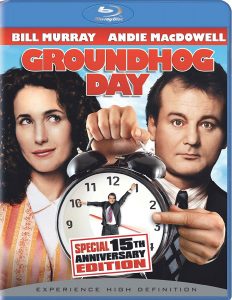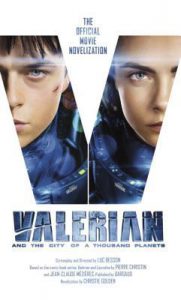After seeing “Valerian and the City of a Thousand Planets,” my No. 1 movie of 2017, I wanted to spend more time in the world, and also try to figure out just what the heck was going on in a couple key sequences. The novelization (July 2017) by Christie Golden, who was becoming one of the top “Star Wars” Legends novelists before that line’s cancellation, mostly delivers the goods.
She puts the emphasis on the relationship between the two agents (played by Dane DeHaan and Cara Delevingne in the film), and gets into their heads as this format does best. It’s my favorite part of the “Valerian and Laureline” franchise, which started 50 years ago as comic books: The fact that the lead adventurers are a couple. The “Star Wars” Legends books gave us some of this with Han and Leia, but it’s neat that Valerian and Laureline are younger. Indeed, “City of a Thousand Planets” tells of the time when they are realizing and admitting they care for each other; presumably they would be married in later films.
Interestingly, Golden spends about 75 percent of the time from Valerian’s point of view and 25 percent from Laureline’s, perhaps because the author found it fun to get into a guy’s head. Since Luc Besson wrote the movie, we have a woman author making sense of a man’s character, and it makes Valerian seem fully formed. There’s a bit of a sweaty-palms sense that Laureline is Valerian’s first love, even though he has a “playlist” of women.
A telling scene comes when shapeshifter Bubble (Rihanna in the film) morphs into Laureline, and Valerian reflects on it on page 220:
He thought about his momentary shock as Bubble had transformed herself into Laureline. How he hadn’t even been tempted to seduce the illusion. … He didn’t want to just make love to her. He wanted to …
“Yes,” he said. “I do love her.”
For her part, Laureline – as is often the case with women in sci-fi – waits for Valerian to mature, or to prove his maturity to her. It’s the main thread in a story wherein the overall theme is to do the right thing. Golden does a wonderful job showing how Laureline is disappointed every time he almost does the right thing or says the right thing, and then how she is thrilled when Valerian finally trusts her judgment and gives the pearl and converter to the Pearl people on page 265:
Laureline smiled. Not with her lips, or even her eyes, but her whole face – her whole being – lit up like a sun. And Valerian knew, whatever happened, that he had made the right choice.
Golden gives us Valerian’s backstory on pages 35 and 209. He was 5 when his mother was killed on a diplomatic mission; he then lived with his grandmother. The author leaves the mystery of his father hanging. The agent somewhat grasps his own emotional shortcomings on page 209:
Emotions flooded Valerian. Five. When he’d lost his mother and, along with her, his innocence about so very much. When ugly revelations and brutal realities had come crashing in on him, which kicked off his own sort of transformation – from Valentin Twain into Valerian into devil-may-care agent.

We learn that the agents have been working together for two years, and we learn raw facts about Laureline more so than her emotional history. In the comics, she was an 11th century French peasant. She helps spatio-temporal agent Valerian on a mission, and then joins him in the service and becomes his partner. In the novelization, though, Laureline “studied ballet when she was a child” (27) and had “an Ivy League education” (32). Unlike the film, Golden uses the comic books’ phrase “spatio-temporal agent” as the duo’s job title, which therefore teases that time travel is possible in this world. However, it seems safe to say Laureline is not from the 11th century in this version.
I hoped to grasp the opening-act sequence at Big Market a bit more, and Golden makes it clearer what’s happening: By wearing the box on his arm, Valerian’s whole body is in Big Market. When he removes it, he leaves that reality and returns to the open desert – and safety. Hence the tension when he can’t remove the box.
I wanted more clarity on why Valerian knows Jolly is not merely a pimp, but actually a slave-owner (thus perhaps justifying his shooting, in order to rescue Bubble), but it’s likewise unexplained in the novelization.
The final sequence remains strange in Golden’s book. It seems as though the section the Pearls have carved out for themselves at the center of Alpha – the titular space-station city – launches itself from the station and floats free to become its own “world.” Golden does not go into any more details, so I’m left to picture somewhat of an inside-out artificial world, like Arthur C. Clarke’s “Rama” or Centerpoint Station in the “Star Wars” Legends books.
Besson, fully embracing the comics’ notion that anything can happen in the “Valerian” universe, made a wild ride of a movie where the action springs from one challenge to another – a film where things mostly hold together, but has some head-scratching moments. Golden recaptures that vibe and provides clarity to some points, and fails to do so on other points. But her writing of Laureline and especially Valerian is the main reason to give it a read.
Click here for a complete index of “Valerian and Laureline” reviews.

